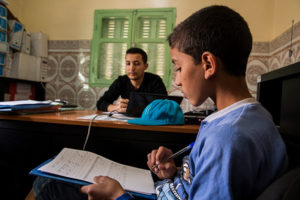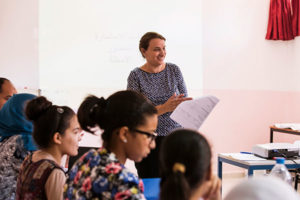Moroccan youth map social services to prevent child labor
By Jillian SlutzkerAugust 10, 2016
With clipboards in hand, middle school-aged youth in the Marrakech region are part of an educational program learning how to conduct some very valuable research that may help prevent child labor.
These apprentice researchers, ages 11 to 14, are part of a cadre of 67 trained “youth mappers” in the Marrakech-Tensift-Al Haouz region helping to create a database, and ultimately visual maps, of available social services in their communities. Using the Creative Mapper approach, they do this after school and as volunteers for local organizations.
As the youth researchers visit health clinics, microfinance institutions, childcare facilities, student dormitories, religious centers and other civil society organizations, they interview staff and catalogue the services offered by each institution. Together, these services can build a social safety net that may provide a family the extra support needed to keep a child in school rather than sending her to work.
“The principal cause for school dropout and child labor is certainly economic and social conditions of the family and accessibility to services,” says Nadia Mannaoui, Creative Mapper trainer and Livelihoods Specialist for the Promise Pathways project, which implements the Creative Mapper initiative.
The Promise Pathways project aims to reduce child labor in the Marrakech-Tensift-Al Haouz area and reach more than 5,500 youth and 1,000 family members. The project is funded by the U.S. Labor Department and implemented by Creative Associates International, along with several local partners.
Mapping to end child labor

An estimated 92,000 Moroccan children ages 7 to14 are working—often in hazardous labor such as agriculture, domestic labor or artisanal sectors—according to Morocco’s High Commission for Planning.
In the Marrakesh-Tensift-Al Haouz region alone, up to 14,000 children are already working or are at great risk of becoming agricultural and domestic laborers.
The Promise Pathways project is partnering with youth, the government and communities to mitigate school dropout. The project also support vocational training providers and employers in providing safe and productive employment for youth of legal working age.
Simultaneously, the project aims to boost household resilience by promoting families’ access to wraparound social services, micro-lending and saving programs.
“At the same time one works on increasing household revenues, one also has to link them to a plan of service for the development of the family,” says Mannaoui.
But first, the community needs to know these wraparound services exist—which is where the youth mappers play a critical role, mapping what services are available and identifying the gaps in a given community.
“I will know that Creative Mapper has fulfilled its purpose if we go out and see no more child labor, no more children cleaning shoes.”
“Our main goal is to recognize and identify the services within our town,” says twelve-year-old Chihab al-Zimrani, a youth mapper in the rural, mountainous town of Imintanoute, about 80 miles from Marrakech.
A key to making this exercise successful, explains youth mapper coach Badr al-Din Ait Bin Hida, is raising awareness in the community about the purpose of Creative Mapper and, subsequently, its findings.
Bin Hida coaches a team of youth mappers, including al-Zimrani, in Imintanoute where, he says, poverty is a serious challenge. If a family is poor and cannot afford school fees, he explains, then they feel they must send their son to work.
However, Bin Hida explains that if this family is made aware of services available in the community—micro-lending, for example, or free school transportation—and how to access them, then the family’s economic situation may improve. The more families taking advantage of such a social safety net will ultimately mean fewer children working, which is the goal for Creative Mapper coaches and mappers.
“I will know that Creative Mapper has fulfilled its purpose if we go out and see no more child labor, no more children cleaning shoes,” says Bin Hida. “This will be our indication that Creative Mapper has done its work.”
Empowering young community leaders

As the lead researchers, youth are the driving force behind Creative Mapper. They are also the key to its long-term success, says Mannaoui.
“When a project intervenes, there is a limited duration…We want these youth to gain a consciousness about their environment and develop the skills to change it. They are the women and men of the future,” she says.
Through the Creative Mapper process, the Promise Pathways team is equipping these young Moroccans with those skills to create positive change.
In intensive two-day training sessions prior to hitting the streets for their surveys, youth mappers learn communication and research skills. They practice interview techniques and discuss ways to raise awareness about Creative Mapper and mobilize the community.
When the actual surveying begins, the youth put their training to work—taking the lead in reaching out to community organizations and working together to diagnose problems they find, and then begin to generate solutions so families can better access services.
The end results, says Mannaoui, is a boost in the youth’s confidence and capacity, as well as a benefit to the larger community in its fight against child labor.
“Creative Mapper has a double objective,” she says.
In addition to the obvious benefits of mapping social services, Creative Mapper helps develop self-esteem, responsibility and decision-making skills. These are life skills that you will not necessarily get in school, she says.
For bin Hida, the coach in Imintanoute, supporting these young people and watching their transformation into community leaders is inspiring.
“The youth can do many things and this helps grow their confidence. Even though they are young, they are talented and creative,” he says. “I don’t feel like I’m the one who is giving here because they are really teaching me.”
Funding for this project was provided by the United States Department of Labor. This material does not necessarily reflect the views or policies of the United States Department of Labor, nor does the mention of trade names, commercial products, or organizations imply endorsement by the United States Government.

